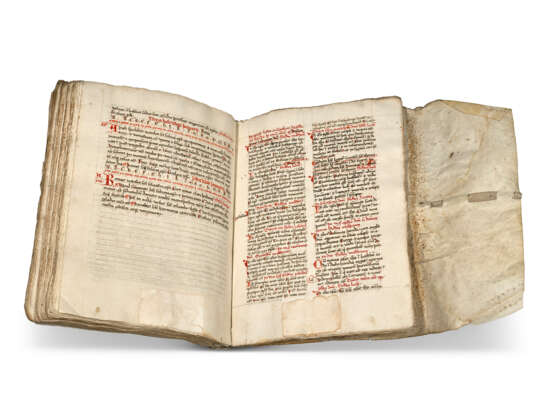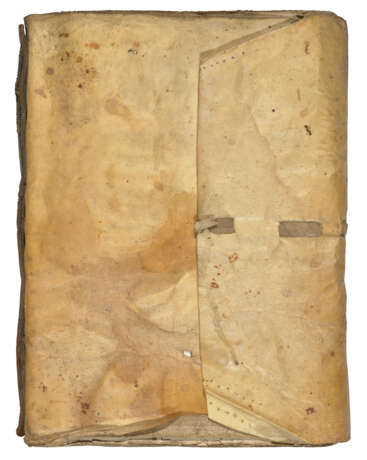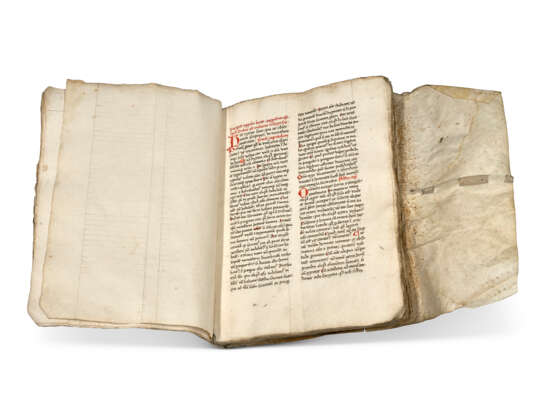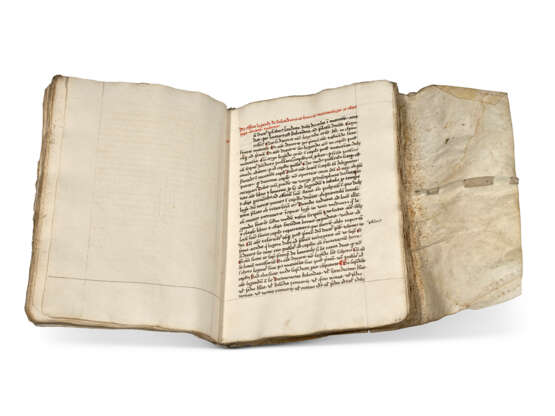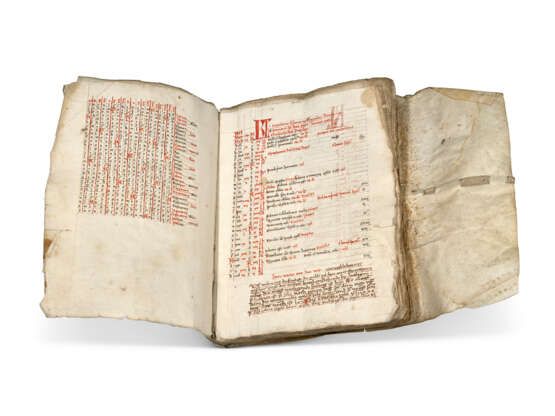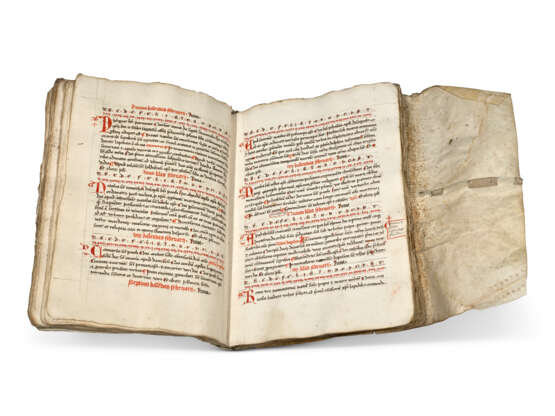ID 1349661
Lot 15 | Rule, Constitutions and Martyrology for Dominican Sisters
Estimate value
£ 7 000 – 10 000
Rule of St Augustine, Constitutions for Dominican Sisters, Martyrology, etc., in Latin with some German, manuscript on paper [Switzerland, Basel?, final quarter 15th century]
The Augustinian Rule, Constitutions and Martyrology adapted for Dominican Sisters – perhaps Klingental Abbey at Basel: a fascinating insight into the rules governing a female institution in the Middle Ages.
305 x 220mm. 92 leaves, complete, collation: 18, 214 (of 18, iv, vi, vii, xiv cancelled leaves, likely reused singletons, the stubs some showing traces of text but no text missing here), 310, 4-812, ff.10-21v and ff.82-88 written in two columns of 36-43 lines, ruled space: c.230 x 76mm, ff.24-81v written in a single column of 33 lines, ruled space: c.225 x 165mm, rubrics and initials in red, capitals touched in red, occasional marginal corrections, notes in German for January, March, and May explaining how to use the Calendar, occasional early annotations in Latin (marginal dampstains to Calendar, small tears in margins of first two leaves and f.55 with some loss to text, repairs at bottom margin of most leaves in the last gathering, gutters reinforced). Bound in a contemporary limp vellum wallet binding, with leather spine and strap (yellowed, a few stains, a little warped, a few holes). In a fitted blue morocco case.
Provenance:
(1) The content of the manuscript makes it clear that it was destined for use by Dominican Sisters. The Calendar contains a number of Dominican feasts, including the translation (28 January), feast (7 March), and octave (14 March) of Thomas Aquinas, Vincent Ferrer on 5 April (he was canonised in 1455), Peter of Verona on 29 April, Catherine of Siena on 30 April, the translation of St Dominic on 24 May 'Translatio beati Dominici prioris nostri', his feast in red on 4 August and octave on 11 August, and the ‘Anniversarium omnium fratrum et sororum ordinis nostri’ on 10 October. On 11 October is the ‘Dedicatio maioris ecclesie Basiliensis’: this is Basel Minster, consecrated on 11 October 1019 by Henry II, Holy Roman Emperor (whose feast we also find in the Calendar in red on 13 July). A Dominican convent in the diocese of Basel could be that of Klingental, a wealthy Abbey that in 1423 tried to avoid the Observant reform of their community by placing themselves under the jurisdiction of the bishop of Constance. An attempt was made in 1480 to reform this community, and when officials read out the reform bull in 1480, the unwilling sisters drowned them out with shouting and threats, and were subsequently locked in their cells by the city’s bailiffs. Thirty-nine of the forty-one sisters left the cloister rather than reform, with nine eventually returning under threat of excommunication for leaving without permission. Ultimately, all the women associated with Klingental during his period disassociated themselves from the Dominican order and joined the Augustinians.
(2) William Ewart Gladstone, Prime Minister (1809-1898): Hawarden Castle library label, MM I II.
Contents: Calendar ff.1-7v; blank f.8; Rule of St Augustine for religious women, ‘Incipit regula beati Augustini episcopi quam scribit ad mulieres religiosas, beginning ‘Hec igitur sunt que ut observetis precipimus in monasterio constitute’ (thus omitting the famous opening line ‘Ante omnia, fratres carissimi’, so as to tailor it specifically to women) ff.10-12v; Constitutions for sisters of the Dominican Order, ‘Incipiunt constituciones sorores quarum cura ordini fratrum predicatorum est commissa’, beginning ‘Quoniam ex precepto regule’ ff.12v-21v; blanks ff.22-23; ‘De officio legendi de kalendario et luna et martirologio et aliis hiis annexis’ ff.24-29; Martyrology for the whole year ff.30-81v; Sunday Gospel readings for the year ff.82-88; blanks ff.89-92.
| Place of origin: | Western Europe, Europe, Switzerland |
|---|---|
| Auction house category: | Medieval & renaissance manuscripts, Books and manuscripts |
| Place of origin: | Western Europe, Europe, Switzerland |
|---|---|
| Auction house category: | Medieval & renaissance manuscripts, Books and manuscripts |
| Address of auction |
CHRISTIE'S 8 King Street, St. James's SW1Y 6QT London United Kingdom | |
|---|---|---|
| Preview |
| |
| Phone | +44 (0)20 7839 9060 | |
| Buyer Premium | see on Website | |
| Conditions of purchase | Conditions of purchase |
